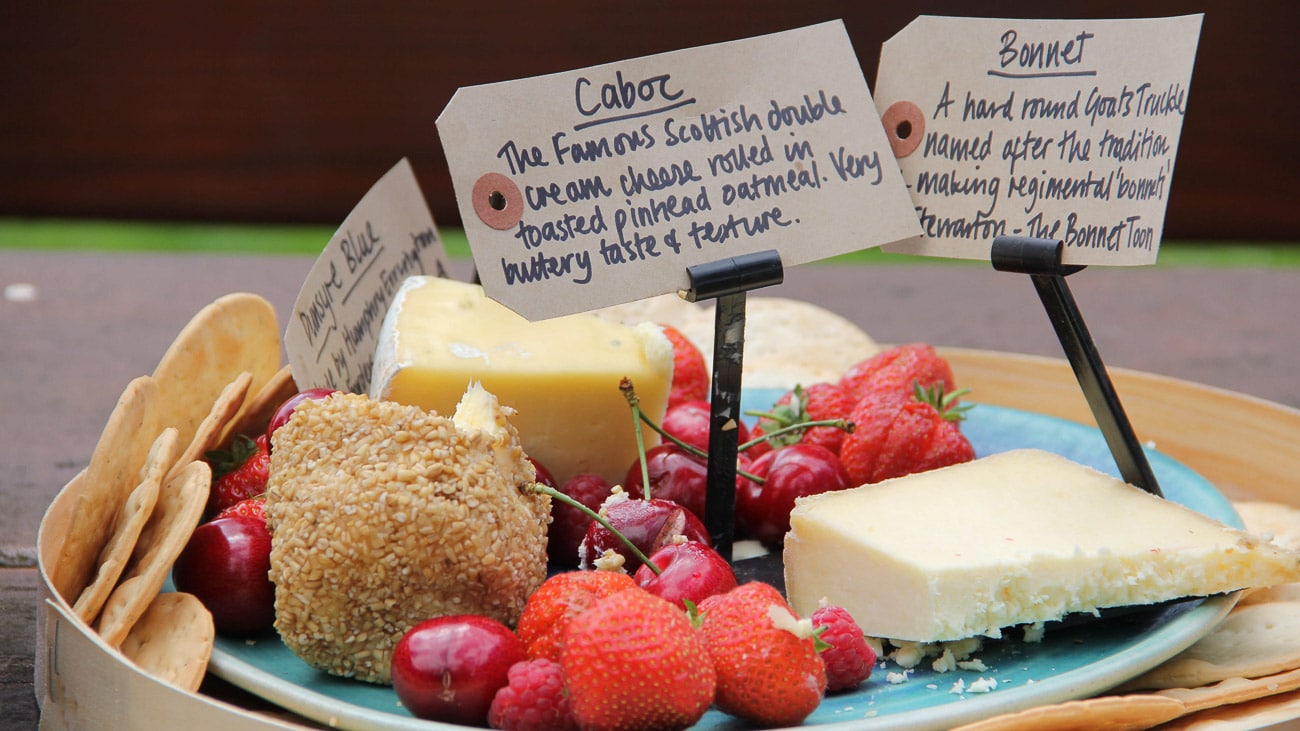What could be better than rolling into a quiet winery with a colorful table spread in the courtyard (accompanied by wine straight from the barrel), or hopping off the bike for a spread of market-fresh food beside a glacial lake? These tips from DuVine guides Alice Walton and Arien Coppock will equip you with the knowledge you need to prepare picnics like a professional.
Choosing Ingredients
Go Local
Since culinary identity is essential to understanding a destination, our guides often plan the picnic around regional specialties. A cheese plate in Tuscany might include a truffle pecorino from Pienza, while in California you’ll probably find a Triple Crème Brie from Marin French Cheese Co. Cured meats are another go-to for showcasing local flavor: try Jamón Ibérico in Spain or the highly coveted Capocollo made from Siena’s Cinta Senese pigs. After all, food that doesn’t travel far tastes freshest.
Stay Seasonal
Let what’s in season guide and inspire you. If you’re planning on making a caprese in winter, you may find Italian markets don’t even carry tomatoes. Instead, hit the local farmer’s market or scan a restaurant’s seasonal menu for inspiration. Strawberry rhubarb crumble seizes the flavors of spring, melon wrapped in prosciutto is widely available in summer, and crisp Vermont apples make an easy snack in the fall. Get creative with what’s available, and let the landscape inspire you.
Play with Flavor and Texture
Salads are a fantastic place to throw it all together. If your idea of salad means romaine with carrots and cucumbers, think outside the box and combine unexpected flavors like sweet, salty, tangy, nutty, and consistencies like crunchy, creamy, crispy, and juicy. Start with your greens or grains, add vegetables, nuts, cheeses, fruits, or protein. Never underestimate how versatile and forgiving a salad can be as your culinary canvas!

Preparing and Packing
Timing and Temperature
When you’re preparing food on the fly, you may be surprised how easy it is to exceed expectations. Keep it simple and consider how your menu will fare under outdoor conditions. For example, if the rosé you’re serving is icy and chilled, guests will find it extra delicious and complementary. On the other hand, nothing spoils a picnic quite like melted cream that was supposed to top your pièce de résistance dessert.
Front-Load the Work
Prepare as many things as possible in advance. Arrive at the picnic with your ingredients pre-cut and stored in plastic containers—the only task left should be to throw things together, plate your dishes, and add finishing touches. Think about making dishes that can be cooked ahead of time, served chilled or at room temperature, and transported easily. If you’re serving wine, choose a screw-top bottle, uncork the wine in advance, or be sure to pack a corkscrew!
It’s Not All Food
A picnic is nothing without the food, but having sticky hands or dirty dishes can detract from the dining experience. Don’t forget easy-to-miss but essential items like napkins or hand wipes, trash bags, paper towels, salt and pepper, cutlery, cutting boards, plastic wine glasses, and mesh tents to protect food from bugs. We also prefer to serve picnics on environmentally conscious enamel plates—they’re light, unbreakable, and more practical than paper plates since they don’t get soggy under dressings or a drizzle of oil.

Tips for Prep and Service
- Set and decorate your table before anything else. That way, guests will feel welcome whether they’re early or on time, and it won’t be obvious if you’re rushing to put last-minute touches on dishes behind the scenes.
- Have a plated dish waiting and set out salads, salumi, or cheese plates as they’re ready.
- Dress your salad at the last possible moment. Not only will this prevent the consistency from turning unappetizing, but it’s a nice aspect of presentation to toss it together as guests are getting settled.
- Plate cheeses and cold cuts last. Once you put them out, they may begin to “sweat.”
- A cooler is your best friend, but use it selectively. Reserve precious real estate for chilled drinks and ingredients that turn or wilt, like dairy or basil.

A Feast for the Eyes
Location, Location, Location
The setting of your picnic can inspire what you’re serving and add a wow factor to the entire experience. In Sonoma, we love to set a spread beneath the trees in Armstrong Redwoods State Park and use the park grills for salmon or asparagus. On our Verona + Lake Garda Tour, we overtake the farmhouse kitchen of our friends Ilaria and Nicola, then serve the picnic with a view of the Valpolicella’s terraced vineyards. On the practical side, it’s a bonus to have a bathroom nearby.
Details and Decoration
Use extra ingredients—spare tomatoes, sprigs of herbs, slices of lemon, or anything else that didn’t make it onto the plate—as garnish or decoration for your table. This serves a double purpose, giving guests a customizable way to add more flavors to their meal. The devil is in the details of a picnic. Set a wildflower atop the place setting or spread olive branches or greenery around the platter for a special touch.

Not sure what to serve? Start with three of our guides’ go-to recipes. These picnic staples have proven popular on tours in California and Italy—they’re simple to make and sure to impress.








